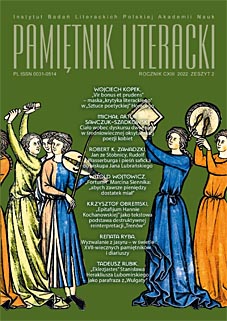Buzyrys, Erazm z Rotterdamu i krwiożercza buzyra
Busiris, Desiderius Erasmus, and Bloodthirsty Buzyra
A Gloss to Samuel Twardowski’s “Dafnis” (“Daphne”)
Author(s): Roman KrzywySubject(s): Language and Literature Studies
Published by: Instytut Badań Literackich Polskiej Akademii Nauk
Keywords: Polish baroque poetry; Samuel Twardowski’s Dafnis (Daphne); poetic language
Summary/Abstract: The article takes up the issue of the enigmatic word “buzyra” present in Samuel Twardowski’s “Dafnis drzewem bobkowym” (“Daphne Transformed into a Laurel Tree”, 1638). Allowing for the contexts of the baroque poet’s output that were absent from the research to this day as well as for a fragment of “Institutio principis Christiani” (“The Education of a Christian Prince”) by Desiderius Erasmus—the piece that mentions the tyrant Busiris, the author of the paper proves that the word refers to a wild beast and is a part of Twardowski’s poetic language. A similar usage is found in a piece by Adrian Wieszczycki. Referring to late output, the author settles that the form “Buzyr” became in the second half of the 17th century Polish language, possibly influenced by Twardowski, also an alternant form of the ancient tyrant’s name (found also at the beginning of the 19th century). The two words, however, differ in grammatical gender: “buzyra” is a common feminine noun, while “Buzyr” is a masculine proper noun.
Journal: Pamiętnik Literacki. Czasopismo kwartalne poświęcone historii i krytyce literatury polskiej
- Issue Year: 113/2022
- Issue No: 2
- Page Range: 185-193
- Page Count: 9
- Language: Polish

